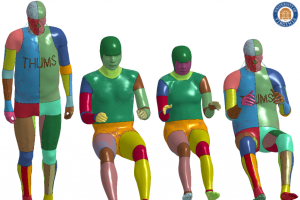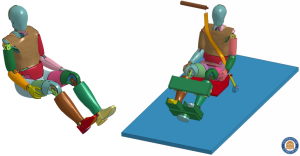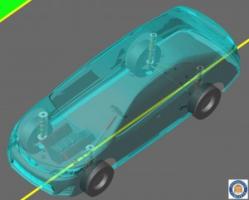Computational Biomechanics
Overview
Computational models are frequently used for predicting occupant responses and injury outcome in vehicle crashes. Working within the CAB experimental efforts is a computational research program with expertise in finite element (FE) modeling and multibody (MB) mechanics. The research program spans development of constitutive models, design of large-scale experiment studies, and vehicle model integration with human and Anthropometric Test Device (ATD) models.
Human Body Models
The Global Human Body Models Consortium (GHBMC) is an automotive industry group that leads academic researchers in computational injury biomechanics to create the most advanced global standard of human body modeling for injury prediction. The initial goal of the project was to develop the finite element model of a 50th percentile male, but has expanded to construct a 5th percentile female model. The CAB is a Center of Expertise (COE) for two major body regions of the GHBMC models: the lower extremities and the thorax for both the 5th and 50th percentile models. In addition to the GHBMC models, the CAB frequently uses the latest THUMS 50th percentile male FE models (both, pedestrian and occupant). Ongoing research projects using THUMS involve pedestrian impact, frontal crash, side impact, lower extremity protection with knee airbags, and human response in rollover.
Dummy Modeling - THOR Finite Element Model
The CAB is the host institution for the THOR (Test device for Human Occupant Restraint) FE dummy model, which has been developed and continuously improved by the National Highway Traffic Safety Administration (NHTSA). THOR has shown enhanced biofidelity under numerous impact loadings compared to the Hybrid III dummy used in current regulations. This research effort is coordinated by the THOR FE model group. The CAB is a leader in this computational group and responsible for lower extremity model development and full body validation. The contributions made by UVA to develop the THOR FE model are essential steps towards the goal of having a robust tool to use in the computational environment for automotive safety improvement.
Multibody Modeling
The advantages of using multibody (MB) as opposed to FE models is that the simulations are relatively short and computationally inexpensive. CAB researchers used these advantages to pioneer an enhanced in-house facet pedestrian human MB model, which is fully scalable from a 3-year-old to a 95th percentile male. The CAB also uses the MADYMO active human body model, which can simulate responses of low pre-crash acceleration and high severity impact scenarios. Therefore, this model was used in rollover research (low acceleration loading) as well as in simulations of underbody blasts. Additionally, CAB researchers developed and validated several MB vehicle models and used them to simulate common types of steering-induced, soil-trip rollovers and evaluate rollover vehicle kinematics due to differences in maneuvering and vehicle type.
Vehicle Crashworthiness in Rollover
The CAB has access to several LS-DYNA finite element (FE) models of vehicles currently available in the U.S. market. Using these models CAB researchers setup and ran FE simulations aimed at determining vehicle kinematics and vehicle deformation patterns which result from rollover impact. In addition, CAB researchers utilized FE analysis to optimize a fabricated buck roof structure used in evaluating ATD biofidelity. The design process was achieved by carrying out FE analysis to facilitate computationally and monetarily inexpensive evaluations of iterative changes to the roof design.




